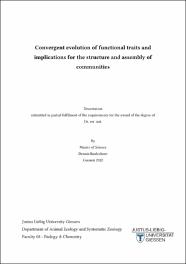| dc.description.abstract | In order to understand and counteract the causes and consequences of the current biodiversity crisis, it is necessary to understand the mechanisms and processes that influence how animal communities assemble. This understanding must go far beyond species numbers, there are other components of biodiversity such as phylogenetic and functional diversity, which give a more informative picture of ecological relationships. Nevertheless, for most animal groups, the relationship between phylogenetic diversity, functional traits and their responses to environmental changes is not clear. This is because for many traits the actual function and the evolutionary patterns and adaptations are often insufficiently understood. Therefore, in this thesis, I combine three approaches and examine the reaction of ground beetle communities to agri-environmental measures in a field investigation (study 1). In the two other studies, I trace the altered biodiversity pattern which I found in the carabid communities of the first study back to evolutionary mechanisms derived from a phylogenetic analysis (study 2) and a series of laboratory experiments (study 3).
With the first study, I demonstrate that agri-environmental measures increase the proportion of medium-sized herbivorous ground beetle species in the community and change the phylogenetic structure, but not the phylogenetic or species diversity. At the same time, however, the proportion of species with functionally unique trait combinations increases. In the second study this pattern could be attributed to the convergent evolution of food preferences, which are linked to morphological adaptations. This explains the consistently high phylogenetic diversity even in functionally more similar communities with altered phylogenetic structure. The specialized mandible shapes are of essential adaptive value, which inter alia could be demonstrated in laboratory experiments with species specialized on Collembola. In addition, generalist species not only showed lower capture efficiency, but also severe weight loss and increased mortality when fed only with Collembola. However, species with highly specialized morphological adaptations are still able to access alternative prey. My results indicate a strong selection pressure on these morphological adaptations regarding herbivory and Collembola as food. Since this finding establishes a strong ecological relationship between feeding groups and their preferred food, these species should therefore not be ecologically classified as omnivorous due to their ability to feed on other food resources as substitutes. It is concluded that phylogenetic diversity cannot predict functional diversity, at least not if it is based on convergent traits as feeding and body size. Even though flowering strips have a particularly positive effect on the number of herbivorous species, a high
Summary
2
phylogenetic diversity is maintained due to the convergent evolution of this trait. High phylogenetic diversity can have a positive effect on the function, resistance and resilience of these communities. Phylogenetic and functional diversity are therefore crucial biodiversity components to maintain the function of communities and ecosystems and should be of central interest in conservation efforts. | de_DE |



